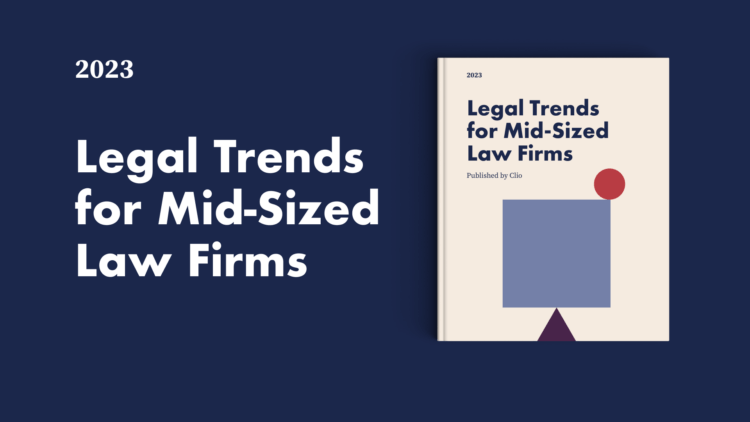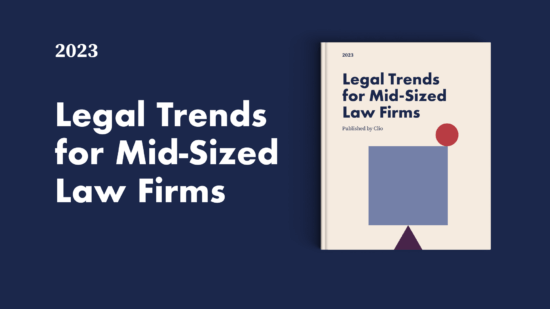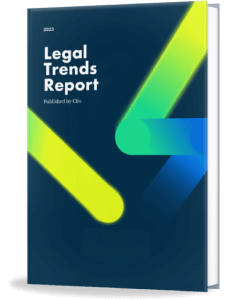Since 2016, legal professionals have relied on Clio’s annual Legal Trends Report for an objective, comprehensive analysis of legal industry trends.
As the legal industry’s most in-depth examination into the state of legal practice, the Legal Trends Report brings together critical insights about law firm performance. It also sheds light on the forces shaping legal practices.
This year, we’re pleased to provide insights unique for mid-sized law firms by expanding our report offerings with the 2023 Legal Trends for Mid-Sized Law Firms report. This report helps mid-sized firms navigate modern challenges, distinguish themselves from smaller firms, and unlock new opportunities.
Introduction to the 2023 Legal Trends for Mid-Sized Law Firms report
The 2023 Legal Trends for Mid-Sized Law Firms report examines what differentiates mid-sized law firms from smaller ones. Measuring success from a single perspective is challenging. That’s why this report explores key trends across various perspectives, including financial performance, personal and professional well-being, and client relationships. We use these insights to identify where mid-sized law firms often face their greatest challenges and how to overcome them.
This report defines mid-sized law firms as those with 21 or more employees. Throughout the report, we compare these firms to “smaller firms” (those with 20 or fewer employees).
Below, we’ll explore key findings from the 2023 Legal Trends for Mid-Sized Law Firms report.
The performance gap between mid-sized firms and smaller firms is shrinking
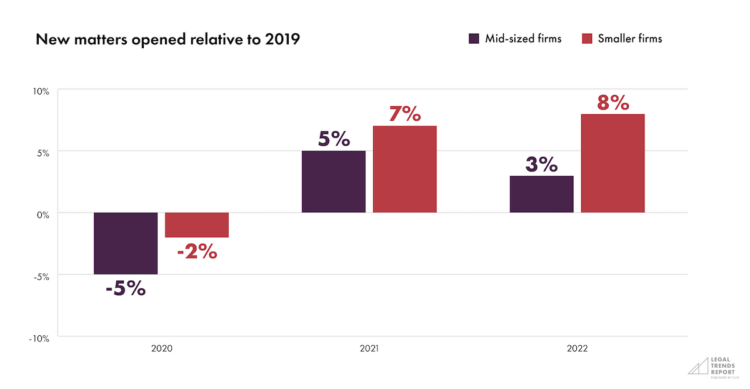
Mid-sized law firms appear to have been significantly impacted by the COVID-19 pandemic. However, they recovered in 2021 and even increased their casework beyond pre-pandemic levels. And, while the increase in casework was modest overall, mid-sized firms have seen tremendous growth in billable amounts. They are significantly outpacing smaller firms in this area.
While multiple factors could be influencing the growth in billable amounts, a convincing argument is that mid-sized firms are more inclined to raise their hourly rates than smaller firms. Mid-sized firms have consistently outpaced smaller firms in raising their hourly rates and even outpaced the Consumer Price Index (CPI).
Despite this increase in billable amounts among mid-sized law firms, the performance gap between mid-sized firms and smaller firms is shrinking.
For example, while mid-sized firms’ utilization rates (the number of hours put toward billable work as measured against an eight-hour workday) climbed slowly from 2019 to 2021, they dropped in 2022. Meanwhile, the utilization rates of smaller firms have remained relatively steady over time.
Similarly, mid-sized firms have historically lagged behind smaller firms’ realization rates (which have remained relatively stable). Still, mid-sized firms are beginning to make gains that are narrowing this gap.
Mid-sized firms are currently outpacing smaller firms in collection rate, but only by a narrow margin.
So, while mid-sized law firms are performing comparatively well, their practices—particularly on key performance indicators—could benefit from improvement.
The wait is over…gain an edge with the latest report.
Get the Report
Attrition rates are high among lawyers in mid-sized firms
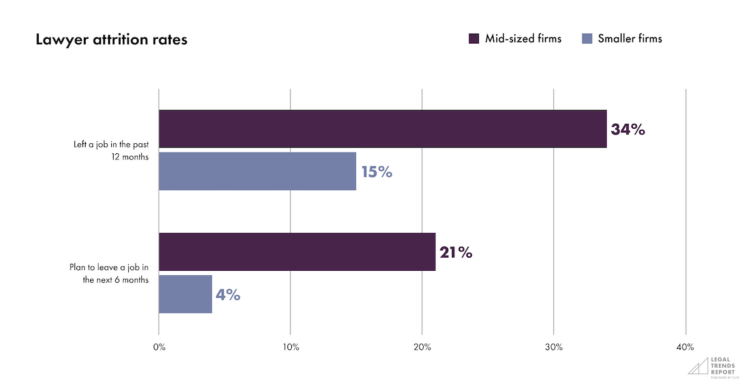
Many lawyers in mid-sized firms left their jobs for new roles in the 12 months before April and May 2022. In fact, lawyers in mid-sized firms were more than twice as likely to have left a job than lawyers in smaller firms. They were also over five times more likely to be planning to leave a job in the following six months.
These shifts can be primarily attributed to dissatisfaction with firms, managers, and coworkers. But many lawyers have moved on to become firm partners and owners. This suggests that a lack of career advancement or partnership opportunities may also be a driving factor for this movement.
More concerningly, lawyers in mid-sized firms aren’t happy. On all counts, lawyers in mid-sized firms report lower satisfaction than smaller firms in their personal and professional lives.
Lawyers in mid-sized firms are working less, but not when they want to
Despite the lower satisfaction rates among lawyers in mid-sized firms, it appears that they find better work-life balance than those in smaller firms—but only in terms of the number of hours worked. Unfortunately, lawyers in mid-sized firms aren’t working during the times or days that they want to be, and we see that 15% of lawyers in mid-sized firms are working late into the night.
At the same time, lawyers in mid-sized firms prefer working in-office. They are less likely to prefer working at home or meeting colleagues or clients virtually—yet these preferences are at odds with modern clients, who prefer virtual meetings over in-person meetings.
Mid-sized firms are falling behind on cloud technology adoption
Technology moves quickly, and many mid-sized law firms need to catch up on technology adoption. Only 27% of mid-sized law firms reported using cloud-based legal practice management (LPM) software (compared to 73% of smaller firms surveyed). They are also less likely to use video conferencing, electronic payments, e-signatures, and cloud-based data storage.
The case for moving to the cloud
Our research suggests that moving to the cloud has obvious benefits for mid-sized law firms. Those who have yet to adopt these technologies are missing out on opportunities to serve clients better and increase employee satisfaction.
Notably,
- Lawyers in mid-sized firms that use cloud-based LPM software report significantly higher performance on all professional and personal metrics, including relationships with colleagues and clients, productivity, and personal and professional satisfaction.
- 53% of lawyers using cloud-based LPM software prefer working at home over going into the office (compared to 35% of lawyers in mid-sized firms who do not use cloud-based LPM software).
- 67% of lawyers in mid-sized firms that use cloud-based LPM software want the autonomy to choose their hours (compared to 34% of those not using cloud-based LPM software).
And, with one in four mid-sized firms already using cloud-based LPM software, the cloud is no longer a “new frontier”.
However, navigating change in a larger organization will ultimately involve more planning and considerations than lawyers in smaller firms. To that end, the 2023 Legal Trends for Mid-Sized Law Firms report provides simple yet effective recommendations for technology adoption in mid-sized law firms.
To learn more about the benefits of cloud-based legal practice management software and further insights, read the 2023 Legal Trends for Mid-Sized Law Firms report today. For further insights on the state of mid-sized firm practice, be sure to read our key highlights from the 2024 Legal Trends for Mid-Sized Law Firms report.
You may like these posts
Where does the data come from?
The Legal Trends Report program uses a range of methodological approaches and data sources. The result? The best insights about the state of legal practice and strategies for future improvement.
Clio app data
We’ve analyzed aggregated and anonymized data from tens of thousands of legal professionals in the U.S. This data provides important insights into how legal professionals use technology and its impact on firm performance.
(Note: Clio only records and reports on application usage. We do not record or report on any details relating to cases and do not identify individual law firms.)
Legal professional and consumer surveys
For the 2023 Legal Trends for Mid-Sized Law Firms report, we surveyed 1,134 legal professionals and 1,168 consumers in April and May 2022. The consumers included in this survey represent the U.S. population based on the most recent U.S. census statistics. This data offers insights into how legal professionals can align more with consumer preferences in 2023 and beyond.
We published this blog post in August 2023. Last updated: .
Categorized in: Clio
